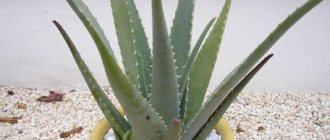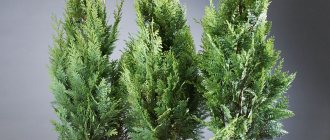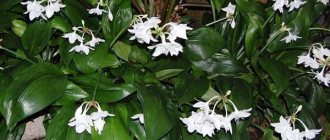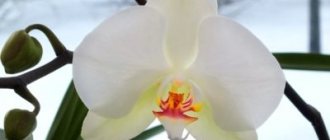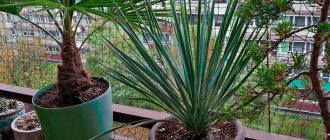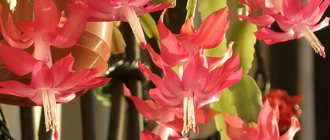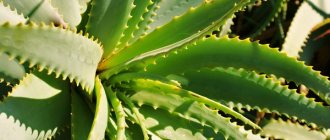Aloe spinosa is a plant belonging to the genus Aloe. Most often it can be seen in pots or flowerpots at home gardeners. The homeland of the culture is considered to be the regions of the Republic of South Africa, located in the east of the state, and the Kingdom of Lesotho, located in the southern part.
The leaves of the crop are collected in a rosette, and their arrangement is spiral-shaped. If you touch the coil, you can feel that its surface is rough and dense, with spines along the edges. The foliage turns into a thin thorn.
The stem is small, one might even say that it does not exist. The length of the rosette reaches up to 20 cm, and the leaves - 10 cm. When aloe spinosa does not bloom, it can be confused with another plant - haworthia.
Planting/growing
Experienced flower growers claim that growing this crop does not require much effort, so even a beginner can cope. The main thing is to follow the basic rule: be sure to add sand and drainage to the soil. Crushed red brick, shards or expanded clay are suitable for the latter.
As for the soil, it is not necessary to buy a special soil mixture, since any soil mixture will do, even leftovers from other crops. The container for aloe should be low but wide. Replantation must be done every year.
Temperature
The culture adapts quite well to high indoor temperatures. For example, the plant will calmly survive a thermometer reading of 24-28 degrees with a plus sign, so in the summer you can take a pot of aloe spinosa to the balcony without fear of harming it. On the contrary, fresh air has a positive effect on perennials, strengthening them.
But in winter, the room temperature should vary from 12 to 18 degrees Celsius. If the indicator reaches +10 degrees, then the development of the flower is inhibited and it may even die. In addition, it is important to avoid drafts.
If we talk about the air humidity in the room, then this parameter is not particularly important. Some house plant lovers try to spray aloe, but this is not necessary. Moreover, this procedure can only cause harm if water gets into the crop outlet and stagnates there. As a result, the plant will begin to hurt.
Botanical portrait
Aloe spinosa is a bushy herbaceous plant with very shortened stems, which often form several (up to 12) groups of rosettes with a circumference of 10–15 cm, curved in the shape of a hemisphere. The leaves are numerous, in some old rosettes there are from 100 to 150 of them, they have a narrow linear shape, about 8–10 cm long and 1–1.5 cm wide. The leaf blades are colored gray-green and studded with white swollen dots, like small peas. Their perimeter edge is framed with small light spines, and the tops end in a long white spine.
Watering
The perennial is not afraid of droughts, since in its homeland it often encounters them, and therefore is well adapted. Aloe spinosa is afraid of excess moisture. But if in winter the pot is in close proximity to a heating device, then the flower should be watered a little more often than usual.
For irrigation, it is allowed to use only water at room temperature. The ideal option is for it to sit for several days beforehand. After each watering, the soil needs to be loosened a little. But the crop cannot be sprayed under any conditions, so the liquid is applied only at the root. This should be done very carefully so that nothing gets on the leaves and rosette.
Caring for aloe spinosa at home involves watering in late spring and summer, when the soil has dried by 1.5 cm. In winter, one irrigation per month is enough. If necessary, the leaves can be wiped off dust with a wet cloth, but no more.
Description
The spinous aloe (aloe aristata) belongs to the succulents of the Xanthorrhoeaceae family. It got its name because of the tendrils (awns) at the ends of the leaves. Its foliage is thick, rough, jagged at the edges, and the stem is practically absent. There are a large number of small white tubercles on the lower part of the leaf.
Bloom
Flowering occurs in the spring-summer period with periodic intervals. In order for the plant to produce a flower, it must have enough diffused daylight, but it should not be placed in direct sunlight.
Flowering begins with the appearance of a peduncle with a small spikelet. And every day it can increase by 1-2 centimeters. The stem can reach up to 40 cm in length. On average, it blooms for about a month. Afterwards, the flowers begin to dry out and eventually fall off, leaving a bare stem that will need to be carefully cut off.
Light
This type of culture is heat-loving, so it loves the sun. At the same time, if you place a pot of aloe spinosa in the shade or in the northern part of the home, its growth will slow down. Therefore, it is important to avoid shady places. But still, in the summer heat, flower growers recommend covering the crop from the sun's rays to protect the rosette from yellowing.
In autumn and spring, fluorescent lamps should be turned on for 2-3 hours. During the growing season, light is needed bright, but at the same time diffused.
Classification and description of the succulent Aloe spinosa
Plant classification
Scientific name: Aristaloe aristata Synonyms: Aloe aristata, Tulista aristata, Aloe longiaristata, Aloe aristata var. leiophylla, Aloe aristata var. parvifolia, Aloe ellenbergeri Common name: Aloe aristata Family: Asphodelaceae Subfamily: Asphodeloideae Genus: Aristaloe
In many sources, this succulent is more often found under the name Aloe aristata. Previously, this species was classified as a member of the Aloe genus. But recent studies have shown that this species is not a member of this genus, but is more closely related to Haworthia and Astroloba. Given its genetic uniqueness, this variety has been moved to its own genus, Aristaloe. But in everyday life this flower is called Aloe spinosa.
Aristaloe aristata is native to the grasslands of Lesotho in South Africa and is a hardy succulent well adapted to life in arid areas. These plants are rarely found in the wild these days due to regular harvesting by local residents.
A short and stemless plant, Aloe spinosa is an attractive, slow-growing flower that forms dense rosettes of fleshy leaves, reaching a height of 40-45 cm. The leaves of this plant are triangular in shape and covered with white teeth and thin cilia, which gives it a striking resemblance to its relatives from genus Haworthia. The leaves are pale green when grown in the shade and dark green in the sun.
Photo of Aloe spinosa flowers
This beautiful plant blooms in late winter or summer, forming a low flower stalk about 50 cm high. An inflorescence with orange-red cylindrical flowers rich in nectar that attract pollinators. The flowers are odorless and have a short flowering period.
This African succulent is very popular as an indoor flower.
You might be interested in other types of Aloe
Aloe multifolia
Aloe tree or Agave: how to grow a medicinal succulent
Medicinal succulent Aloe vera
Feeding
Aloe spinosa, when growing in the wild, easily finds food for development and growth in the desert and stones. But, if it is grown at home, it needs feeding in the summer.
Ready-made complexes for cacti can be used as fertilizer. But before use, it is important to read the instructions so as not to exceed the dosage. This condition is important to fulfill, since an excess of nutritional components has a detrimental effect on the decorative effect of the flower. Fertilize after each watering every 14 days.
Biology of the species
In the natural environment, Aloe spinosa grows only in South Africa. It is distributed in the Kingdom of Lesotho and in the Eastern regions of the Republic of South Africa. Aloe loves warm and dry climates. It grows mainly in mountain meadows at altitudes up to 2300 m above sea level. It can be found on rocky soil among other plants.
Wild species can grow to larger sizes than houseplants. Their leaf rosettes sometimes grow up to 60 cm in diameter, and the peduncle up to 50-70 cm in height. At home, its height, as a rule, does not exceed 30 cm.
Aloe spinosa in its natural habitat.
Aloe blooms annually in late spring or early summer. After flowering ends, achenes are formed, which dry out over time, crumble and serve the natural spread of the plant.
The succulent also reproduces by root shoots. When the plant becomes an adult (after about 3-4 years), it grows small leafy rosettes connected to the mother plant by underground side shoots.
The lifespan of Aloe spinosa ranges from 5 to 20 years. Because it is a succulent plant, aloe can tolerate long periods of drought and go up to several months without watering. Excessive soil moisture, for example, as a result of heavy rainfall, can lead to rotting of the roots and death of the plant.
Pot
Aloe spinosa is an indoor plant that is planted in a container with a diameter several centimeters larger than the expected size of the rosette. The height of the pot should not be large, because the root system of the plant is superficial. But the soil used should be loose, and the shoots that branch should be in the pot without constraint.
Varieties of succulent Aloe spinosa
As already indicated, the genus Aristaloe contains only one species - Aristaloe aristata. But there are several hybrids of this plant and its variegated form is Aristaloe aristata variegata.
Photo of Aristaloe aristata variegata
We will briefly describe some hybrid varieties.
x Gasteraloe beguinii lizard tail
This is an intergeneric hybrid of Gasteria carinata var. verrucosa and Aristaloe aristata. Forms round rosettes with beautiful warty soft leaves.
Gasteria, like Aloe, hybridize easily, and cross-pollination can produce interesting hybrid plants.
x Gasteraloe 'Cosmo'
Another hybrid of Aloe spinosa and an unknown species of Gasteria. A fairly robust plant with thick, wide, dark green leaves with white dots.
The succulent is easy to care for.
x Gasteraloe cv. RoyalHighness
This is a rare intergeneric hybrid of Gasteria batesiana and Aloe aristata. It is richly decorated with a dense scattering of raised white dots.
Photo of hybrid x Gasteraloe cv. RoyalHighness
Moderate stress from bright light and drought can cause leaves to turn orange and red. This slow growing loose rosette makes an excellent houseplant as it can grow well even in low light.
The soil
In order for the crop to be healthy and beautiful, the soil in the container must be neutral or low in acidity. In order for the roots to “breathe” you need:
- gravel;
- charcoal;
- brick crushed to crumbs.
You can prepare the soil for aloe yourself. For this you will need turf, leaf soil, sand and humus. First, drainage should be poured into the bottom of the pot, the layer of which should reach 4 cm, then small stones. This approach will protect the root system from excessive moisture.
Transfer
Transplantation should be carried out annually if we are talking about young plants, and once every two years if the flower is already 5 or 6 years old. In the first case, the need for frequent replanting lies in the rapid growth of the crop, and therefore there is little space for the roots. The ideal time for the procedure is March-April. For everything to go right, you will need a special substrate for cacti. You can prepare it yourself using:
- leaf soil;
- sand;
- turf;
- expanded clay drainage.
Mix all ingredients. To obtain the required acidity, add 2 tsp to the resulting mixture. add 2 tsp peat peat
Transplant stages:
- Pour the drainage into a 3 cm layer into a prepared container.
- Add soil.
- Water.
- Replant the flower without removing the earthen ball from the roots.
After completing the procedure, despite the love of aloe spinosa for the sun, you cannot immediately place it in a well-lit area. Accustoming to light should be gradual.
You can change the “place of residence” of a plant unscheduled if:
- parasites appeared in the soil;
- shoots appeared near the stem;
- the roots are exposed;
- many dried shoots.
If you transplant Aloe spinosa in winter, it may die from stress.
Benefits and medicinal properties
The plant is grown not only for its decorative value. Aloe has long been famous for its medicinal properties, therefore it is widely used for medical and cosmetic purposes. Based on it, you can prepare products that will relieve inflammation, relieve pain and destroy pathogenic microorganisms.
In addition, aloe spinosa can be used to treat:
- liver and stomach diseases;
- respiratory infections;
- tonsillitis;
- bronchitis.
Aloe juice also helps strengthen the immune system, removes toxins, and fights constipation. The flower is also useful for the skin: it gets rid of pimples and acne, slows down aging, and restores youth and elasticity. The positive effects on the body have been confirmed by medical research.
But, despite the positive properties of the plant, there are also contraindications:
- chronic illnesses;
- allergy to aloe;
- heart and vascular diseases;
- pregnancy;
- bleeding.
Beneficial features
Aloe has rich healing properties that have been used for thousands of years. Methods of using the plant in medicine and cosmetology:
- The pulp of the culture is famous for its anti-inflammatory effect and is used to treat wounds, abrasions, burns and ulcers. Draws pus out of the wound and speeds up healing. To do this, you need to cut the sheet lengthwise and apply it to the damaged area; you can fix it with a medical bandage. It is recommended to change compresses once every 2-3 hours until the wound is completely healed.
- Aloe juice is used to treat gastrointestinal diseases, gynecological problems and colds. For example, if you have a cold, you need to mix honey with lemon and add aloe juice and consume it with meals. Thanks to the large amount of vitamins and antioxidants contained in the plant, the juice will help the body recover quickly.
- Aloe juice is also used for cosmetic purposes to treat problem skin and strengthen hair. It is used both in pure form and as part of masks and compresses. Has an antibacterial, moisturizing and tightening effect.
However, before starting treatment, it is important to familiarize yourself with the contraindications for use, these are:
- exacerbation of chronic diseases;
- plant allergy;
- cardiovascular diseases;
- pregnancy and menstruation;
- bleeding of any kind.
Reproduction
In aloe, spinous reproduction is possible in several ways. It doesn’t matter which one you choose, if you follow all the rules, the flower will definitely take root. They begin to sow it in January, and the emerging seedlings will get stronger by the next winter.
The seeds should be treated with potassium permanganate and planted in garden soil with sand. Cover the container with glass and place in a warm place. When the seedlings hatch, they need to be watered, ventilated, and when leaves appear, transplanted into separate pots.
Propagation of aloe spinous processes is the simplest method that is possible during the period of its active growth. This procedure consists of the following steps:
- A cutting with several leaves should be cut at the base of the flower.
- Next, it needs to be treated with charcoal powder and dried. This will take 4 to 5 days.
- Then place the shoot into 1 cm of sand.
- Place the container on the window, creating protection from sunlight and ensuring a temperature of 20 degrees Celsius.
- Water until roots appear.
Young leaves will appear in about 20 days. Only after this can the crop be transplanted to a permanent location.
There is another way to propagate aloe, which is grown as a houseplant. In the warm season, the top should be shortened so that a maximum of 7 leaves remain on the shoot.
It is placed cut side down in a glass. After 7 days (this is exactly how long it takes for roots to appear), you can plant them in the ground and water them.
Problems and pests of Aloe spinosa
The most common problems in succulent care are most likely caused by improper watering. A properly watered Aloe aristata plant can resist most pests and diseases.
The wilting of succulent leaves is the result of a lack of water in summer.
Rot is usually caused by too much water. Use a fungicide to try to treat the disease, but you also need to eliminate the problem causing the rot.
Yellowing of leaves with rotting at the base is the result of overwatering of plants kept in a cooler environment during the dormant period. Rotting of the leaves can also be associated with improper watering, when not only the soil, but also the plant itself is moistened. Moisture is collected and retained on the leaves, which leads to putrefactive processes.
Common Pests
Mealybugs can attack both the leaves of a flower and its roots. They can hide deep in the crevices of rosette foliage, and the root ones usually burrow into the ground, just below the soil surface.
How to get rid of it? Remove visible insects from the foliage with a toothpick or damp cloth, or a small, stiff brush dipped in methyl alcohol or an insecticide solution. Then spray all the tops with an appropriate pesticide. To kill scale insects in the soil, you can add systemic pesticide granules to the soil mixture. Check your plants weekly for the next month for signs of re-infestation.
Scale insects can also attack this plant. Pests can be easily removed mechanically, washed off with a stream of water or scraped off with cotton swabs. Appropriate pesticides can also be applied.
